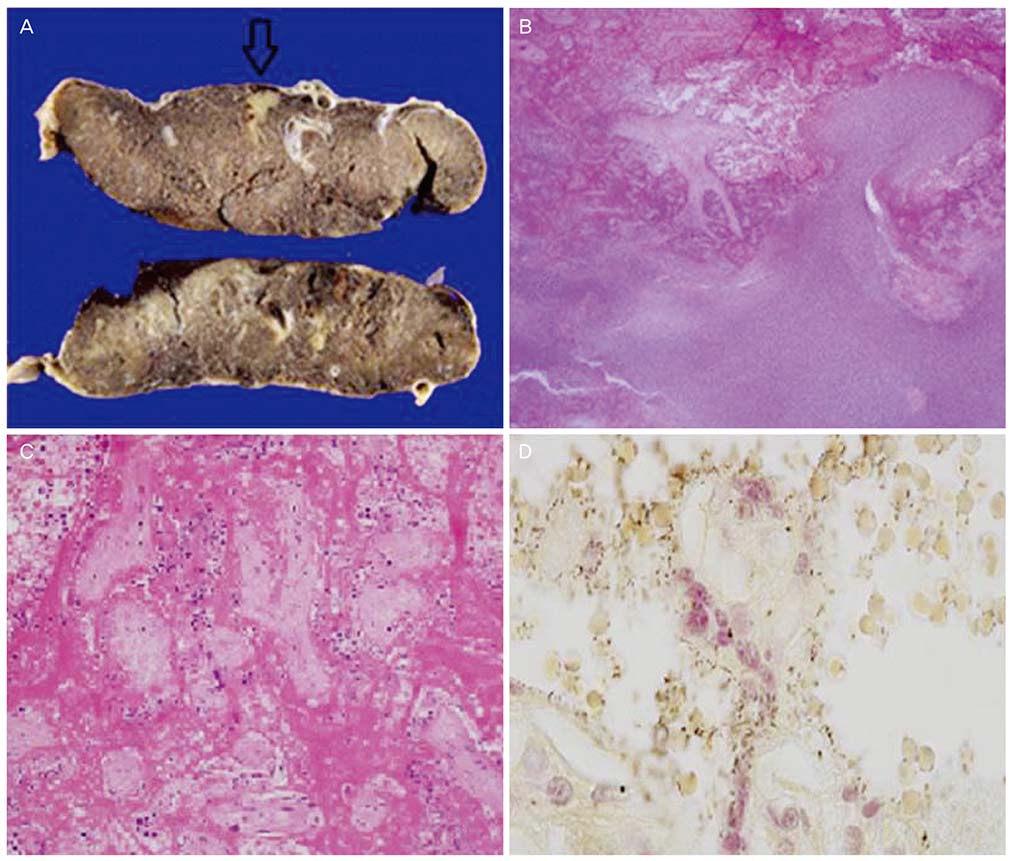Obstet Gynecol Sci.
2018 Nov;61(6):688-692. 10.5468/ogs.2018.61.6.688.
Challenging management of chorioamnionitis with placental listeriosis: lessons from 2 cases
- Affiliations
-
- 1Department of Obstetrics and Gynecology, Uijeongbu St. Mary's Hospital, The Catholic University of Korea College of Medicine, Uijeongbu, Korea. yoni@catholic.ac.kr
- 2Department of Pathology, The Catholic University of Korea College of Medicine, Seoul, Korea.
- 3Department of Obstetrics and Gynecology, Seoul St. Mary's Hospital, The Catholic University of Korea College of Medicine, Seoul, Korea.
- KMID: 2426013
- DOI: http://doi.org/10.5468/ogs.2018.61.6.688
Abstract
- Listeriosis is a rare foodborne infection caused by Listeria monocytogenes. It is 12-20 times more prevalent in pregnant women compared to the general population, with a 20-40% mortality rate in neonates. Early treatment with appropriate antimicrobial agents is critical for pregnancy outcomes; however, the infection is difficult to control because the nonspecific clinical manifestations and rarity of the disease often preclude early diagnosis. We encountered 2 cases of pregnancy-associated listeriosis that occurred at 29 and 37 weeks of gestation. Both neonates were delivered by emergent cesarean section due to fetal condition, and one of the preterm infants died immediately after birth. Pregnancy-associated listeriosis should be considered in the management of unexplained fever or inflammatory conditions in pregnant women.
Keyword
MeSH Terms
Figure
Cited by 2 articles
-
Listeriosis in a Pregnant Woman and a Neonate
Ha Young Yun, Juhui Kim, Su Jin Cho, Eun Ae Park, Young Ju Kim, Sunwha Park
Ewha Med J. 2020;43(4):60-64. doi: 10.12771/emj.2020.43.4.60.Listeriosis During Pregnancy
Hye Sim Kang, Rina Kim, Soon Sup Shim
J Korean Matern Child Health. 2025;29(2):55-61. doi: 10.21896/jkmch.2025.29.2.55.
Reference
-
1. Gray ML, Killinger AH. Listeria monocytogenes and listeric infections. Bacteriol Rev. 1966; 30:309–382.2. de Noordhout CM, Devleesschauwer B, Angulo FJ, Verbeke G, Haagsma J, Kirk M, et al. The global burden of listeriosis: a systematic review and meta-analysis. Lancet Infect Dis. 2014; 14:1073–1082.
Article3. Bubonja-Sonje M, Mustac E, Brunn A, Deckert M, Abram M. Listeriosis in pregnancy: case report and retrospective study. J Matern Fetal Neonatal Med. 2013; 26:321–323.
Article4. Lamont RF, Sobel J, Mazaki-Tovi S, Kusanovic JP, Vaisbuch E, Kim SK, et al. Listeriosis in human pregnancy: a systematic review. J Perinat Med. 2011; 39:227–236.
Article5. de Valk H, Jacquet C, Goulet V, Vaillant V, Perra A, Simon F, et al. Surveillance of Listeria infections in Europe. Euro Surveill. 2005; 10:251–255.6. Elinav H, Hershko-Klement A, Valinsky L, Jaffe J, Wiseman A, Shimon H, et al. Pregnancy-associated listeriosis: clinical characteristics and geospatial analysis of a 10-year period in Israel. Clin Infect Dis. 2014; 59:953–961.
Article7. Committee on Obstetric Practice, American College of Obstetricians and Gynecologists. Committee opinion No. 614: management of pregnant women with presumptive exposure to Listeria monocytogenes . Obstet Gynecol. 2014; 124:1241–1244.8. Charlier C, Goffinet F, Azria E, Leclercq A, Lecuit M. Inadequate management of pregnancy-associated listeriosis: lessons from four case reports. Clin Microbiol Infect. 2014; 20:246–249.
Article9. Barikbin P, Sallmon H, Hüseman D, Sarioglu N, Weichert A, von Weizsäcker K, et al. Clinical, laboratory, and placental findings in perinatal listeriosis. Fetal Pediatr Pathol. 2016; 35:307–314.
Article10. Awofisayo A, Amar C, Ruggles R, Elson R, Adak GK, Mook P, et al. Pregnancy-associated listeriosis in England and Wales. Epidemiol Infect. 2015; 143:249–256.
Article11. Charlier C, Perrodeau É, Leclercq A, Cazenave B, Pilmis B, Henry B, et al. Clinical features and prognostic factors of listeriosis: the MONALISA national prospective cohort study. Lancet Infect Dis. 2017; 17:510–519.12. Mazor M, Froimovich M, Lazer S, Maymon E, Glezerman M. Listeria monocytogenes. The role of transabdominal amniocentesis in febrile patients with preterm labor. Arch Gynecol Obstet. 1992; 252:109–112.13. Sapuan S, Kortsalioudaki C, Anthony M, Chang J, Embleton ND, Geethanath RM, et al. Neonatal listeriosis in the UK 2004–2014. J Infect. 2017; 74:236–242.
Article14. Thønnings S, Knudsen JD, Schønheyder HC, Søgaard M, Arpi M, Gradel KO, et al. Antibiotic treatment and mortality in patients with Listeria monocytogenes meningitis or bacteraemia. Clin Microbiol Infect. 2016; 22:725–730.15. Committee on Obstetric Practice. Committee opinion No. 712: intrapartum management of intraamniotic infection. Obstet Gynecol. 2017; 130:e95–e101.
- Full Text Links
- Actions
-
Cited
- CITED
-
- Close
- Share
- Similar articles
-
- Listeria Sepsis and Pneumonia in a Premature Neonate
- Listeriosis in a Pregnant Woman and a Neonate
- The relationship between amniotic fluid white blood cell count and the presence and severity of acute placental inflammation in preterm premature rupture of membrane
- The relationship between the presence, severity and pattern of acute placental inflammation and amniotic fluid interleukin-8 in preterm labor
- Listeriosis in baby and mother confirmed with blood and amniotic fluid cultures


